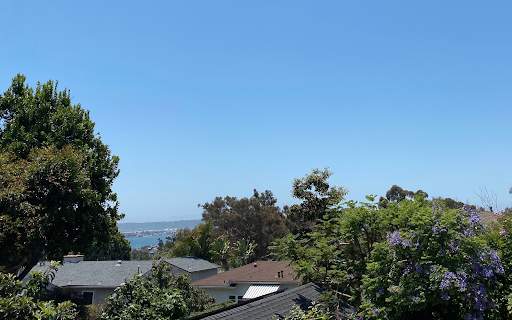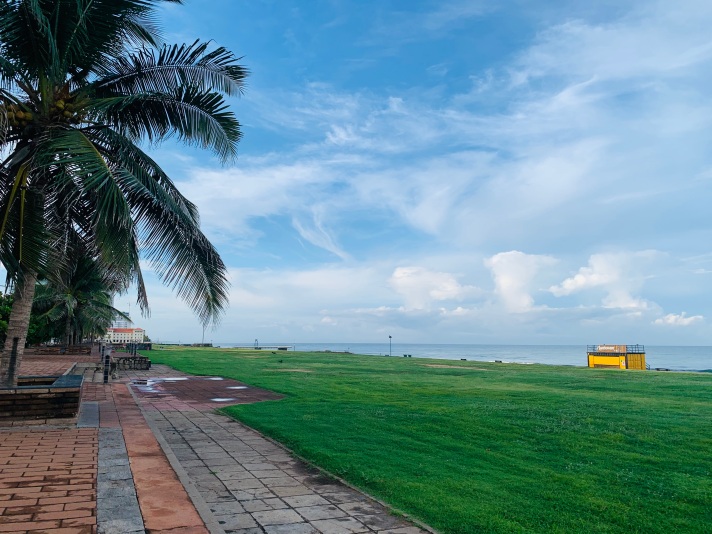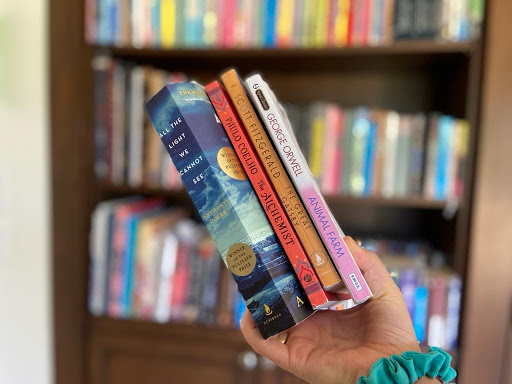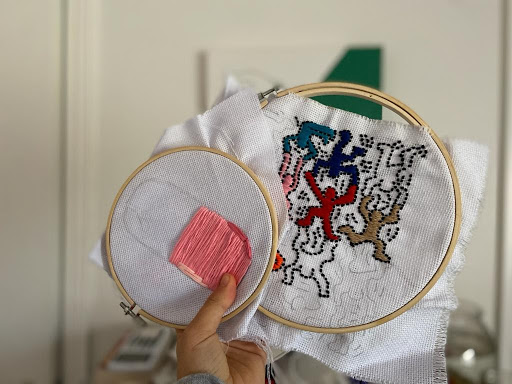Lions’ Den reporters Rosie Alchalel (’21), Ron Gneezy (’21), and Kayla Swartzberg (’21) wade into the complex debate about the ethics of life during the Coronavirus quarantine.
The Death of Liberty
By Kayla Swartzberg (‘21)

Cartoon by Tom Stiglich (used with permission)
Constitutional Amendment I: “Congress shall make no law respecting an establishment of religion, or prohibiting the free exercise thereof; or abridging the freedom of speech, or of the press; or the right of the people peaceably to assemble, and to petition the government for a redress of grievances.”
“Oppressed people cannot remain oppressed forever. The yearning for freedom eventually manifests itself,” –Martin Luther King Jr.
“There may be times when we are powerless to prevent injustice, but there must never be a time when we fail to protest,” –Elie Wiesel.
“Any society that will give up a little liberty to gain a little security will deserve neither and lose both,” –Benjamin Franklin.
*
Remember when everyday civilians would flood into the streets to defend their rights and liberty by resisting tyrannical, power-hungry leaders? Remember when pop culture oozed messages of resistance, of freedom, and of rights? Well, apparently resistance isn’t cool anymore.
It used to be that if you didn’t resist the tyranny of our government, then you weren’t a true patriot.
Of course, until patriots began to protest the heavy-handed, illogical restrictions that were placed on their basic freedoms by governors taking advantage of the coronavirus pandemic to excuse their hefty use of executive power. That resistance is despicable, disgusting, and a killer.
To clear the air, Americans aren’t just protesting because they are forced to stay at home, to slowly suffer economically due to social distancing rules (33 million unemployed), or to—as the media states—place their paycheck over human life.
The protests only began occurring when governors started to flex their powers in unreasonable ways.
On Easter Sunday, Christians were given citations for attending church services in their cars. Skateboard parks in Southern California were intentionally filled with sand so kids were unable to ride, even though it is almost impossible to be in close physical proximity with another person while skateboarding. Purchasing seeds and paint became illegal in Michigan.
These protocols are irrational. They are heavy-handed and don’t serve a true purpose, except perhaps showing off the elected officials’ temporary powers.
We the people of the United States aren’t impressed.
But journalists who think the First Amendment only refers to them, and celebrities who think the rules refer to anyone but them, are outraged. In fact, many journalists are actively trying to stop citizens from peacefully assembling and using their voices to oppose state government protocols. Oh, because free speech isn’t cool anymore either.
On April 20th, ABC News host George Stephanopoulos slammed Facebook CEO Mark Zuckerberg for letting protest organizers use the Facebook platform. Not long after, the posts by protestors were taken down under the guise of it being “harmful misinformation.” Journalists patted themselves on the back and poured themselves a drink for helping to remove the posts.
Yet it seems ironic that the journalists are the ones celebrating a corporation giving into the demands of an elected official, who wanted plans for political protests removed from a public website.
Ultimately, when elected officials outlaw safe church gatherings and start using drones to monitor (say “spy on”) private gatherings on Americans’ private properties, patriotic resistance is needed. If the American people don’t protect and defend our rights, we betray those men at Yorktown who fought and died for them.
Still, I am practicing “social distancing.” I stay away from other people. I do it voluntarily.
Voluntarism and force are two different things. The government is force, and the media wants that.
CNN’s Don Lemon says, “Ten states have no stay-at-home orders! Some governors are still refusing to take action!”
In Raleigh, North Carolina, people came together to protest one of those “stay-at-home” orders. The police arrested a protestor and tweeted, “Protesting is a non-essential activity.”
But the Constitution—the foundation of our country, what makes America the greatest and freest country in the world—gives Americans the right to “peacefully assemble” and also “petition the government for a redress of grievances.”
The truth is that the coronavirus doesn’t override the Constitution.
Protests have occurred in Michigan, where Governor Gretchen Whitmer imposed some questionable rules. Whitmer stated, “All public or private gatherings of any size are prohibited.” Her order stopped people from seeing family and banned anyone with more than one home to travel between them. And while many condemn the Michigan protests due to the open display of firearms and Confederate flags, others recognize that it is their right to carry guns inside the state Capitol under open-carry laws, and it is also within their right to wave any flag they wish. This is still America, the country of freedom. Isn’t it?
In Encinitas, California, police fined people $1,000 for sitting in their cars to watch the sunset at the beach. Inside their cars. The police said, “We want compliance from everybody (because of the) lives that we’re trying to save.”
And in Calumet County, Wisconsin police officers were captured on video at a woman’s house because she “violated a state order” by allowing her daughter to play at a neighbor’s house. They scolded her and told her to take her daughter home.
Calumet County has had zero coronavirus deaths.
With all this, America seems crazy compared to Sweden.
Sweden is encouraging its older citizens and immune-compromised people to stay inside at home. They don’t want crowded hospitals. Other than that, Sweden is carrying on as normal. Epidemiologist Anders Tegnell of the Swedish Health Agency said, “Closing schools, stringent measures like that, closing borders, you cannot do that for months or years… What we are doing in Sweden we can continue doing for a very long time… The long run matters most.”
Their hope: once enough people get coronavirus, the immunity will prevent mass outbreaks later.
Other European countries have also concluded that lockdowns aren’t sustainable.
Germany has reopened retail stores. Denmark has reopened their nursery and elementary schools. Norway has reopened schools. Austria has reopened ships to people who wear masks. That seems smarter than the “absolute shutdown” promoted by many American authorities. Mayor Eric Garcetti of Los Angeles threatened to “shut off water and power” to houses of people who don’t shelter in place.
Yes—shutting off people’s water and power.
Politicians are limiting our choices and freedom in the name of safety. They don’t consider places like Sweden or the argument that maybe leaving Americans alone might actually make us safer. Believe it or not, many people have enough common sense to stay away from each other when asked.
But no. It is important to remember: Politicians love pushing people around.
Politicians are taking measures that do nothing to combat the coronavirus. Some of which are locking public parks where people are social distancing and banning Americans from buying supplies. Americans are beginning to wonder if their politicians are trustworthy. And when politicians answer the questions with hysteria that the questioners don’t care about human life, people grow even more suspicious.
In the State of Washington, Snohomish County Sheriff Adam Fortney won’t enforce the governor’s stay-at-home orders because he says Washington residents have shown that they are capable of keeping “themselves, their families and neighbors safe and healthy.”
Fortney also recognizes the hypocrisy in it, as he says, “Our Governor [Jay Inslee] has told us that private building construction must stop as it is not essential, but government construction is okay to continue.” He continues, “So let me get this right, according to the Governor if you are employed or contracted by the government to build government things you can still make a living for your family in spite of any health risk. If you are a construction worker in the private sector you cannot make a living and support your family because the health risk is too high. This contradiction is not okay and in my opinion is bordering on unethical.”
Washington is one of many states that has seen rallies protesting stay-at-home orders.
Demonstrators, both Democratic and Republican, have rallied in states across the country to protest their governors’ stay-at-home orders that have kept Americans out of work.
Recently, thousands of San Diegans showed up outside the Hall of Justice to protest against lockdown orders in the “ReOpen San Diego” rally. People held up signs as cars drove by, honking horns of support. Planning for the rally started on the day that the San Diego County public health team ordered everyone to wear a mask or face-covering when within six feet of someone not in your household.
Perhaps most important to note was that San Diego Police were on the scene, however the protest was peaceful and everyone stayed on the sidewalks and out of the road. Again, it is a right for Americans to peacefully protest. A peaceful protest, like the San Diego protest and many others, is allowed to occur.
Especially now.
Besides the governors’ illogical restrictions and the current mass unemployment, Americans are stressed and mentally drained. People are looking to substances and alcohol for comfort. Alcoholics Anonymous stated that the lockdown has presented a “near constant trigger” for recovering alcoholics already struggling against the way they associate being at home with drinking. And mounting data suggests that domestic abuse is also on the rise. Home isolation, however vital it is to fight against the pandemic—sociologist Dr. Marianne Hester explains—is giving power to the abuser. Isolation also has shattered support networks, making it harder for victims to help or escape.
To sum it up, Americans are allowed to protest. They are allowed to “peacefully assemble.” And in these times of mass unemployment, domestic violence, alcoholism, drug-addiction, depression, and governors using their newfound powers to take unreasonable measures—it seems logical that these people should protest.
If Americans truly believe that everyone should blindly obey the commands of government officials basking in power and oozing in hypocrisy then America could turn into a very scary country indeed.
Works Cited
Betz, Bradford. “Washington County Sheriff Says He Won’t Enforce Governor’s Stay-at-Home Order.” Fox News, FOX News Network, 22 Apr. 2020, http://www.foxnews.com/us/washington-county-sheriff-wont-enforce-governors-stay-at-home-order.
“Breaking: Police Show Up at Woman’s Home for Violating Lockdown After Daughter’s Playdate.” 100PercentFedUp.Com, 29 Apr. 2020, 100percentfedup.com/breaking-police-show-up-at-womans-home-for-violating-lockdown-after-daughters-playdate/.
Fox News. “Fox News.” California Skate Park Filled with Sand to Enforce Social Distancing Backfires as Dirt Bikers Show Up, apple.news/AJYIIE6tfSNKcjGvip3T3BQ.
KUSI Newsroom. “Large Crowds of People Show up to Participate in the ‘ReOpen San Diego’ Rally to Protest Lockdown Orders -.” McKinnon Broadcasting, 1 May 2020, http://www.kusi.com/large-crowds-of-people-show-up-to-participate-in-the-reopen-san-diego-rally-to-protest-lockdown-orders/.
Norris, Michele. “Opinion | Firearms at Protests Have Become Normalized. That Isn’t Okay.” The Washington Post, WP Company, 6 May 2020, http://www.washingtonpost.com/opinions/firearms-at-protests-have-become-normalized-that-isnt-okay/2020/05/06/19b9354e-8fc9-11ea-a0bc-4e9ad4866d21_story.html.
O’Connor, Larry. “Apparently Resistance Isn’t Cool Anymore.” Townhall, Townhall.com, 21 Apr. 2020, townhall.com/columnists/larryoconnor/2020/04/21/apparently-resistance-isnt-cool-anymore-n2567308.
Quinn, Ben, and Nicola Kelly. “Online Support Groups for Alcoholics on the Rise during Lockdown.” The Guardian, Guardian News and Media, 13 Apr. 2020, http://www.theguardian.com/world/2020/apr/13/online-support-groups-for-alcoholics-on-the-rise-during-lockdown.
Shapiro, Ben. “Every Crisis an Opportunity.” Townhall, Townhall.com, 22 Apr. 2020, townhall.com/columnists/benshapiro/2020/04/22/every-crisis-an-opportunity-n2567375.
Sorace, Stephen. “Coronavirus Shutdown: What States Have Seen Protests against Stay-at-Home Orders.” Fox News, FOX News Network, 21 Apr. 2020, http://www.foxnews.com/us/coronavirus-shutdown-what-states-have-protested-against-stay-at-home-orders.
Stossel, John. “Government Goes Too Far.” Townhall, Townhall.com, 22 Apr. 2020, townhall.com/columnists/johnstossel/2020/04/22/government-goes-too-far-n2567356.
Tappe, Anneken. “30 Million Americans Have Filed Initial Unemployment Claims since Mid-March.” CNN, Cable News Network, 30 Apr. 2020, http://www.cnn.com/2020/04/30/economy/unemployment-benefits-coronavirus/index.html.
Taub, Amanda. “A New Covid-19 Crisis: Domestic Abuse Rises Worldwide.” The New York Times, The New York Times, 6 Apr. 2020, http://www.nytimes.com/2020/04/06/world/coronavirus-domestic-violence.html.
Give Me Liberty AND Give Me Death
Hundreds take to the streets to protest the shutdown
By Rosie Alchalel (‘21) and Ron Gneezy (‘21)

Quarantine protestors and police alike gather outside the statehouse in Columbus, Ohio on April 18, 2020 (Wikimedia Commons)
As coronavirus-related panic and hysteria grip the nation and the world, reactions from various groups of people differ. While many stay at home and practice healthy safety measures such as social distancing and wearing masks, others take to the streets bearing semiautomatic weapons and Confederate flags.
The measures these so-called “First Amendment” protestors are taking, have been–in a true stroke of irony–in violation of the First Amendment, which ensures all Americans the right to peaceful protests. Not only is the nature of the protests dangerous, congregating in large groups has been proven to promote the spread of the virus. Many protestors even bring military grade weapons along with them. In Michigan, the protests — in addition to charging the state capitol building — took place strategically in front of a hospital. Not very peaceful, right?
The protestors can be seen bearing signs such slogans as MY VIRUS, MY CHOICE (mocking Pro-Choicers) and DEFUND SCIENCE. It is not radical to ask oneself if the shutdown is really what they’re protesting. Perhaps this goes deeper: an effort to promote their racist, xenophobic agenda.
In Michigan, one protestor held up a sign reading “Heil Whitmer,” in reference to the state’s Jewish governor, Gretchen Whitmer.
In Columbus, Ohio, a car passenger displayed a sign which read THE REAL PROBLEM and bore an image of a rat with a kippah and a Star of David.
For some, this isn’t a war on the government, nor a war on the virus. Many protestors have turned this into a war on minorities.
Another interesting trend seems to be signs which incorporate facts, with many reading “facts not feelings.” Well, the facts point toward a lockdown. Toward isolating ourselves to deter the spread of the virus.
The facts are plain and simple: don’t touch your face; wear a mask; stay six feet away; socially isolate.
The government is obliged to keep us safe, to promote our well-being and, eventually, help us be rid of this virus. It is nearly impossible for the government to keep us safe if we won’t take the necessary protective measures ourselves. Even if there is an argument that other rights are inalienable, the most vital of the inalienable rights is the right to life, and in order to secure that right, we need to temporarily give up the rights to liberty and the pursuit of happiness. It is neither illogical nor immoral for the government to put in place these restrictive measures, it is simply what must be done in order to promote our well-being and the general welfare. To ensure we don’t get sick. To save lives.
Nevertheless, President Trump has urged Governor Whitmer to “make a deal,” with these “very good people” (yes, he is referring to the same people bearing rifles and signs unapologetically attacking her Jewish heritage). The President believes that she should “give a little, and put out the fire.” For protestors acting so selfishly in opposition to facts, it seems highly unlikely that they will be satisfied with “a little.”
With a swift turn to history, it is evident that at times the government has granted itself the authority to perform limited breaches of the First Amendment.
In 1917, a socialist named Charles T. Schenk was arrested for passing out flyers urging resistance to the draft during World War I. He was arrested and his sentencing was famously upheld in the Supreme Court in a case titled Schenck v. US. Justice Oliver Wendell Holmes declared that the government can limit free speech if it provides “a clear and present danger” to U.S. citizens. The coronavirus is as clear and present a danger as can exist. Unlike the threat of war overseas, the virus it is already at large within our nation.
These protestors provide “a clear and present danger” toward the well-being of all Americans as they actively promote an agenda which completely disregards safety measures that are in place to save lives. Therefore, it is well within the authority of the government to terminate the protests.
Don’t get us wrong. We want our normal lives back, we want the economy to be booming again, and we want the right to protest. But none of that is worth having at the expense of our health–and ultimately at the expense of our lives and the lives of our loved ones.
We recognize that these lockdowns aren’t sustainable indefinitely. But it is not up to citizens to decide when this ends. It is up to the government and, more specifically, the scientifically educated members of the government.
At the end of the day, it is impossible to tell COVID-19 what to do. Protesting with big guns and xenophobic slurs will not scare away the virus. So, for the time being, we must be obedient, not only to the government but to the facts. And the facts scream, “stay home.”
Works Cited
Cortellessa, Eric. “US Far-Right Extremists Are Now Calling Social Distancing a Nazi Policy.” Timesofisrael.com, The Times of Israel, 17 Apr. 2020, http://www.timesofisrael.com/us-far-right-extremists-are-now-calling-social-distancing-a-nazi-policy/.
Ellis, Emma Grey. “The Anti-Quarantine Protests Aren’t About Covid-19.” Wired, Conde Nast, www.wired.com/story/anti-lockdown-protests-online/.
Hancock, Laura. “Some Ohio Coronavirus Protesters Using Anti-Semitic Symbolism.” Cleveland.com, Cleveland.com, 21 Apr. 2020, http://www.cleveland.com/open/2020/04/some-ohio-coronavirus-protesters-using-anti-semitism-symbolism.html.
Lombardo, Timothy. “Perspective | The Far Right Hates Liberals, Government and the Media – and Now, Quarantines.” The Washington Post, WP Company, 21 Apr. 2020, www.washingtonpost.com/outlook/2020/04/21/far-right-distrust-quarantine/.
Phillips, Morgan. “More Lockdown Protests Taking Place across the Country as Other States Begin to Open Up.” Fox News, FOX News Network, 1 May 2020, http://www.foxnews.com/politics/lockdown-protests-as-other-states-open.



















